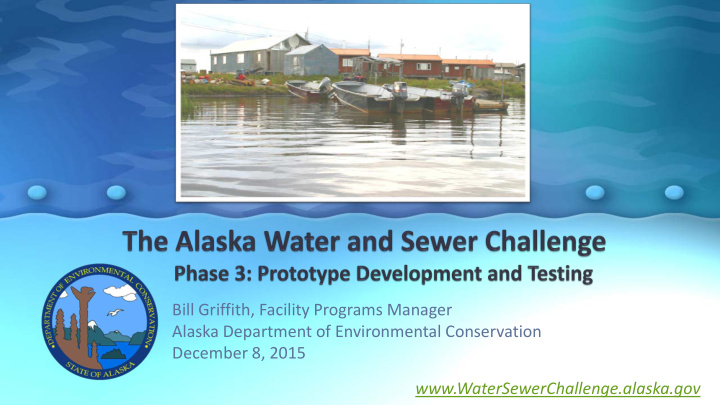



Bill Griffith, Facility Programs Manager Alaska Department of Environmental Conservation December 8, 2015 www.WaterSewerChallenge.alaska.gov
Progress in Alaska Village Sanitation For half a century, we’ve focused on getting rid of the honey bucket. Much progress has been made: 30 years ago, fewer than 25% of rural Alaska households had running water and flush toilets. In 1996, 55% of rural homes had piped or covered haul service. Today, approximately 85% of rural homes have indoor plumbing (over 90% if regional hubs are included in the calculation).
However… Lack of in-home water and sewer service in rural Alaska causes severe skin infections and respiratory illnesses. Conventional, community-wide piped systems and truck haul systems are expensive to construct, maintain and replace. Many communities cannot afford the high operation and maintenance costs associated with piped or haul systems. Available funding is not adequate to serve remaining homes (approximately 3,300) and make needed improvements. Innovative approaches were needed in order to address health problems associated with water and sewer system deficiencies.
Alaska Water and Sewer Challenge State-funded research and development project projected to last 5 – 7 years Focus is on “decentralized” approaches – household based systems that utilize water re-use technologies Private sector driven – with ownership of intellectual property retained by project teams Goal is to significantly reduce the capital and operating costs of in-home running water and sewer in rural Alaska homes Funding to date is $4 million in state and federal funding. Additional funding will be required to complete the project
Performance Targets Acceptance by users Parts Affordable Availability Operation Sufficient Water for Health Benefits Feasible Durability Capital Feasibility Cost Freeze Recovery Capability
Multi-Agency Steering Committee State Tribal Federal
Village Input End users provide the most valuable feedback for appropriate technology design ADEC partnership with rural communities to better inform the development of future home-based systems Teams are required to work with communities from different regions
Project Timeline Approximate Duration Phase (months) Timeframe Team Fall 2013 – 9 Spring 2014 Formation Proposal Fall 2014 – 8 Summer 2015 Development + Presentation Prototype December 2015 – 21 Summer 2017 Development + Pilot Testing Field System Fall 2017 – 21 Summer 2019 Development + Testing Technology 2020 and beyond ? Refinement + Improvement
DOWL Alaska Inc. Team lead: Janelle Rogers (425) 256-1255 / RogersJD@cdmsmith.com Summit Consulting Services Inc. Team lead: Dave Cramer (907) 291-2339 / TeresaAtSummit@aol.com www.facebook.com/summitakwsc/ University of Alaska Anchorage Team lead: Aaron Dotson (907) 786-6041 / addotson@uaa.alaska.edu www.reusewaterak.com
THANK YOU! More questions: Fatima.Ochante@alaska.gov Bill.Griffith@alaska.gov Project Website: WaterSewerChallenge.alaska.gov
Team: DOWL Alaska ALASKA WATER & SEWER CHALLENGE: PHASE 3
Significant experience leading international experts on watsan projects in Ghana, DOWL Indonesia, Tanzania, Crimea, Mozambique, Central Asia, and Armenia Team USAID, MCC, & World Bank consultancies PhD in engineering mgt. & social science undergrad 4 years as construction engineer leading watsan project in Alaska villages Janelle Rogers RogersJD@cdmsmith.com / (425) 256-1255 / http://www.dowl.com/Contact-Us 30+ years experience as water treatment specialist with CDM Smith and World Bank Developed “high tech” whole house water treatment system with no chemicals required Developed “low tech” ceramic disk filter system for household water treatment for Mayan Indian communities in Guatemala Co-author of book covering treatment processes for communities in Chris Schulz developing countries PhD Public Health anthropologist Worked in public acceptance of technology for the past 28 years Worked in Water and Sanitation for Health (WASH) for 15 years Led WASH studies of public acceptance and use in 3 countries Laurie Krieger Co-author of "game changing" World Bank report on sustainable sanitation in rural Bangladesh Multiple years of Arctic Engineering experience Capital improvement projects in 55 Alaska villages Implemented over $30 Million of Projects in Alaska Multiple regions: YK Delta, NW Arctic, Interior Alaska, North Slope, and Southeast Alaska Chase Nelson
DOWL Proposed System
End-User Input Engaged end-users. Using input from these communities, we arrived at the vestibule design. Next Steps: Construct Prototype at CCHRC/Fairbanks and CCHRC/Fairbanks continue interaction with communities during development
Team: Summit Consulting ALASKA WATER & SEWER CHALLENGE: PHASE 3
AL ASKA WAT E R + SE WE R CHAL L E NGE Summit Co nsulting Se rvic e s T ue sda y, De c e mb e r 8, 2015 http:/ / wa te rse we rc ha lle ng e .a la ska .g o v / Ge ne ra l q ue stio ns a b o ut Summit’ s pro po sa l? Co nta c t 222.5424 o r me g ha n@ a g ne wb e c k.c o m
Qualific ations 17
18
19
E nd Use r Input 58% 25% 11% 3% 3% 2. 3. 4. c o mfo rta b le c o mfo rta b le 5. Ve ry 1. No t Co mfo rt with re c yc le d wa te r use fo r ha ndwa shing 20
Team: University of Alaska Anchorage ALASKA WATER & SEWER CHALLENGE: PHASE 3
Our Team
On-site Water Reuse
Our Collaborating Communities Kipnuk & Koyukuk Connecting Household Collaborative Community-Driven Health to Public Engineering Health Water quality, Open-source Water reuse quantity and built availability Maintained Sanitary waste Fixtures to fit for/by the management community
Alaska Water & Sewer Challenge Phase 3 – Prototype Development and Pilot Testing Press Conference : 10:00AM - December 8 th , 2015 – Voth Hall Primary Team Contact Team Website Aaron D. Dotson, Ph.D., P.E. ReuseWaterAK.com State of Alaska Website (907) 786-6041 WaterSewerChallenge.alaska.gov addotson@uaa.alaska.edu
Questions & Answers ALASKA WATER & SEWER CHALLENGE: PHASE 3 www.Wat aterSewerChal allenge.al alas aska. a.gov
Recommend
More recommend